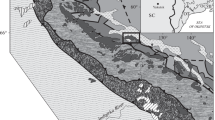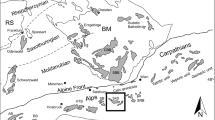Abstract
A geochemically and mineralogically diverse group of granitoids is present within an area of 900 km2 in the southern Snake Range of eastern Nevada. The granitoids exposed range in age from Jurassic through Cretaceous to Oligocene and include two calcic intrusions, two different types of two-mica granites, and aplites. The younger intrusions appear to have been emplaced at progressively more shallow depths. All of these granitoid types are represented elsewhere in the eastern Great Basin, but the southern Snake Range is distinguished by the grouping of all these types within a relatively small area.
The Jurassic calcic pluton of the Snake Creek-Williams Canyon area displays large and systematic chemical and mineralogical zonation over a horizontal distance of five km. Although major element variations in the pluton compare closely with Daly's average andesite-dacite-rhyolite over an SiO2 range of 63 to 76 percent, trace element (Rb, Sr, Ba) variations show that the zonation is the result of in situ fractional crystallization, with the formation of relatively mafic cumulates on at least one wall of the magma chamber. Models of trace element and isotopic data indicate that relatively little assimilation took place at the level of crystallization. Nonetheless, an initial 87Sr/86Sr value of 0.7071 and δ 18O values of 10.2 to 12.2 permil suggest a lower crustal magma that was contaminated by upper crustal clastic sedimentary rocks before crystallization. The involvement of mantle-derived magmas in its genesis is difficult to rule out. Two other Jurassic plutons show isotopic and chemical similarities to the Snake Creek-Williams Canyon pluton.
Cretaceous granites from eastern Nevada that contain phenocrystic muscovite are strongly peraluminous, and have high initial Sr-isotope ratios and other features characteristic of S-type granitoids. They were probably derived from Proterozoic metasediments and granite gneisses that comprise the middle crust of this region.
Another group of granitoids (including the Tertiary aplites) show chemical, mineralogic, and isotopic characteristics intermediate between the first two groups and may have been derived by contamination of magmas from the lower crust by the midcrustal metasediments.
Similar content being viewed by others
References
Armstrong RL (1966) K-Ar dating using neutron activation for Ar analysis. Geochim Cosmochim Acta 30:565–600
Armstrong RL (1968) Sevier orogenic belt in Nevada and Utah. Geol Soc Amer Bull 70:429–458
Barth TFW (1962) Theoretical petrology [2nd ed]. John Wiley and Sons Inc, New York, p 416
Bateman PC, Chappell BW (1979) Crystallization, fractionation, and solidification of the Tuolumne Intrusive Series, Yosemite National Park, California. Geol Soc Am Bull 90:465–482
Beckinsale RD (1979) Granite magmatism in the tin belt of southeast Asia. In: Origin of granite batholiths. Geochemical evidence, Atherton MP and Tarney J (eds) Shiva Publishing, Ltd, p 34–44
Best MG, Armstrong RL, Graustein WC, Embree GF, Ahlborn RC (1974) Mica granites of the Kern Mountains pluton, eastern White Pine County, Nevada — Mobilized basement of the Cordilleran miogeosyncline? Geol Soc Am Bull 85:1,277–1,286
Cain D (1974) The determination and interpretation of rare earth abundances in hybrid granitoid rocks of the southern Snake Range, Nevada. Colorado School of Mines, Golden, unpubl MS thesis, 94 p
Chappell BW, White AJR (1974) Two contrasting granite types. Pac Geol 8:173–174
Crecraft HR, Nash WP, Evans SH (1981) Late Cenozoic volcanism at Twin Peaks, Utah: Geology and Petrology. J Geophys Res 86:10303–10320
DePaolo DJ (1981) Trace element and isotopic effects of combined wallrock assimilation and fractional crystallization. Earth and Planet Sci Lett 53:189–202
Drewes H (1958) Structural geology of the southern Snake Range, Nevada. Geol Soc Am Bull 69:221–239
Farmer GL, DePaolo DJ (1980) Nd and Sr isotopic evidence on the source of silicic intrusive rocks in the northern Great Basin, Geol Soc Am Abst Prog 12, 423–424
Farmer GL, DePaolo DJ (1981) Nd and Sr isotopic evidence on the crustal structure and composition of the northern Great Basin. EOS 62, 45, 1039
Faure G, Powell JL (1972) Strontium isotope geology. Springer-Verlag, p 188
Furgeson J, Chappell BW, Goleby AB (1980) Granitoids in the Pine Creek Geosyncline. Proceedings of International Uranium Symposium on the Pine Creek Geosyncline, International Atomic Energy Agency, pp 73–89
Gilluly J (1963) The tectonic evolution of the Western United States — 17th William Smith lecture. Geol Soc London Quart Jour, 119:133–174
Halliday AN, Stephens WE, Harmon RS (1980) Rb-Sr and O isotopic relationships in 3 zoned Caledonian granitic plutons, southern Uplands. Scotland: Evidence for varied sources and hybridization of magmas. J Geol Soc London 137:329–348
Hanson GN (1978) The application of trace elements to the petrogenesis of igneous rocks of granitic composition. Earth Planet Sci Lett 38:26–43
Hildreth W (1979) The Bishop Tuff: Evidence for the origin of compositional zonation in silicic magma chambers. Geol Soc Am Spec Pap 180:43–75
Hose RK, Blake MC (1976) Geology of White Pine County, Nevada. Nevada Bureau of Mines and Geology Bulletin 85, pt 1, pp 1–35
Kistler RW, Ghent ED, O'Neil JR (1981) Petrogenesis of garnet two-mica granites in the Ruby Mountains, Nevada. J Geophys Res 86: (Bull) 10591–10606
Lee DE, Bastron H (1967) Fractionation of rare-earth elements in allanite and monazite as related to geology of the Mt Wheeler mine area, Nevada. Geochim Cosmochim Acta 31:339–356
Lee DE, Doering WP (1974) Barium in hybrid granitoid rocks of the southern Snake Range, Nevada. J Res US Geol Surv 2:671–675
Lee DE, Doering WP (1980) Rubidium and strontium in hybrid granitoid rocks, southern Snake Range, Nevada. US Geol Surv Prof Pap 1158A:1–8
Lee DE, Friedman I, Gleason JD (1981) Map showing the oxygen isotope composition of granitoid rocks of the Basin-Range Province: US Geological Survey Miscellaneous Field Studies Map MF 1305, scale 1:3, 168,000
Lee DE, Friedman I, Gleason JD (1982) The oxygen isotope composition of granitoid and sedimentary rocks of the southern Snake Range, Nevada. Contrib Mineral Petrol 79:150–158
Lee DE, Friedman I, Gleason JD (1983) Negative δ 18O values found for eastern Nevada plutonic rocks deformed by stresses resulting from postcrystallization movement along spatially related thrust faults. In: Shorter Contributions to Isotope Research, US Geol Surv Prof Pap, Chap. N
Lee DE, Kistler RW, Friedman I, Van Loenen RE (1981) Two-mica granites of northeastern Nevada. J Geophys Res 86:(Bull) 10607–10616
Lee DE, Kistler RW, Robinson AC (1983) The strontium isotope composition of granitoid rocks from the southern Snake Range, Nevada. In: Shorter Contributions to Isotope Research, US Geol Surv Prof Pap, Chap. P
Lee DE, Marvin RF, Mehnert HH (1980) A radiometric age study of Mesozoic-Cenozoic metamorphism in eastern White Pine County, Nevada, and nearby Utah. US Geol Surv Prof Pap 1158-C:17–28
Lee DE, Marvin RF, Stern TW, Peterman ZE (1970) Modification of potassiumargon ages by Tertiary thrusting in the Snake Range, White Pine County, Nevada. In: Geological Survey research 1970. US Geol Surv Prof Pap 700-D:D196-D206
Lee DE, Mays RE, Van Loenen RE, Rose HJ Jr (1969) Accessory sphene from hybrid rocks of the Mount Wheeler mine area, Nevada. In: Geological Survey research 1969. US Geol Surv Prof Pap 650-B:B41-B46
Lee DE, Mays RE, Van Loenen RE, Rose HJ Jr (1971) Accessory epidote from hybrid granitoid rocks of the Mount Wheeler mine area, Nevada. In: Geological Survey research 1971. US Geol Surv Prof Pap 750-C:C112-C116
Lee DE, Stacey JS, Fischer L (1983) Muscovite-phenocrystic twomica granites of northeastern Nevada are Late Cretaceous in age. In: Shorter Contributions to Isotope Research, US Geol Surv Prof Pap, Chap. D
Lee DE, Stern TW, Marvin RF (1981) Uranium-thorium-lead isotopic ages of zircon from the southern Snake Range, Nevada. Isochron/West 31:25
Lee DE, Stern TW, Mays RE, Van Loenen RE (1968) Accessory zircon from granitoid rocks of the Mount Wheeler mine area, Nevada. In: Geological Survey research 1968. US Geol Surv Prof Pap 600-D: D197-D203
Lee DE, Van Loenen RE (1970) Biotites from hybrid granitoid rocks of the southern Snake Range, Nevada. In: Geological Survey research 1970. US Geol Surv Prof Pap 700-D:D196-D206
Lee DE, Van Loenen RE (1971) Hybrid granitoid rocks of the southern Snake Range, Nevada. US Geol Surv Prof Pap 668:p 48
Lee DE, Van Loenen RE (1979) Accessory opaque oxides from hybrid granitoid rocks of the southern Snake Range, Nevada. US Geol Surv Open-File Rep 79–1608: p 14
Lee DE, Van Loenen RE, Brandt ELM (1980) Feldspars from hybrid granitoid rocks of the southern Snake Range, Nevada. US Geol Surv Open-File Rep 80–322: p 11
Lee DE, Van Loenen RE, Mays RE (1973) Accessory apatite from hybrid granitoid rocks of the southern Snake Range, Nevada. Jour Research US Geol Surv 1:89–98
McCarthy TS, Groves DI (1979) The Blue Tier Batholith, northeastern Tasmania: A cumulate-like product of fractional crystallization. Contrib Mineral Petrol 71, 193–209
McCarthy TS, Hasty RA (1976) Trace element distribution patterns and their relationship to the crystallization of granitic melts. Geochim Cosmochim Acta 40:1351–1358
Masi V, O'Neil JR, Kistler RW (1981) Stable isotope systematics in Mesozoic granites of central and northern California and southwestern Oregon. Contrib Mineral Petrol 76:116–126
Michard-Vitrac A, Albarede F, Dupuis C, Taylor HP (1980) The genesis of Variscan (Hercynian) plutonic rocks: Inferences from Sr, Pb, and O studies on the Maladeta igneous comples, central Pyrenees (Spain) Contrib Mineral Petrol 72:57–72
Misch P, Hazzard JC (1962) Stratigraphy and metamorphism of Late Precambrian rocks in central northeastern Nevada and adjacent Utah. Am Assoc Petrol Geol Bull 46:289–343
Moore WJ, Hedge CE, Sorensen ML (1979) Variations in 87Sr/86Sr ratios of igneous rocks along the Uinta trend, northwestern Utah. Geol Soc Am Abst Prog 11, 297
O'Neil JR, Chappell BC (1977) Oxygen and hydrogen isotope relations in the Berridale batholith: Jour Geol Soc London 133:559–571
Peacock MA (1931) Classification of igneous rock series. Jour Geol 39:54–67
Pirsson LV (1947) Rocks and rock minerals (3rd ed., revised by Adolph Knopf). John Wiley & Sons, Inc, New York, p 349
Stacey JS, Zartman RE (1978) A lead and strontium isotopic study of igneous rocks and ores from the Gold Hill mining district, Utah. Utah Geol 5:1–15
Stewart JH (1980) Geology of Nevada. Nevada Bureau of Mines Geol Special Publication 4, p 136
Streckeisen AL (1973) Plutonic rocks; Classification and nomenclature. Geotimes 18, 26–30
Stuckless JS, Miesch AT (1981) Petrogenetic modeling of a potential uranium source rock Granite Mountains, Wyoming. US Geol Survey Prof Pap 1225:1–34
Taylor HP Jr (1968) The oxygen isotope geochemistry of igneous rocks. Contrib Mineral Petrol 19:1–71
Taylor HP (1980) The effects of assimilation of country rocks by magmas on 18O/16O and 87Sr/86Sr systematics in igneous rocks. Earth Planet Sci Lett 47:243–254
Taylor HP, Silver LT (1978) Oxygen isotope relationships in plutonic rocks of the Peninsular Ranges Batholith, southern and Baja California. US Geol Surv Open-File Rep 78–701, 423–426
Tindle AG, Pearce JA (1981) Petrogenetic modeling of in situ fractional crystallization in the zoned Lock Doon pluton, Scotland. Contrib Mineral Petrol 78:196–207
Wenner DB (1981) Oxygen isotopic composition of the late orogenic granites in the Southern Piedmont of the Appalachian Mountains, USA, and their relationship to subcrustal structures and lithologies. Earth Planet Sci Lett 58:186–199
White AJR, Chappell BW (1977) Ultra-metamorphism and granitoid genesis. Tectonophys 43:7–22
Whitebread DH (1969) Geologic map of the Wheeler Peak and Garrison quadrangles, White Pine County, Nevada, and Milford County, Utah. US Geol Surv Miscellaneous Geologic Investigations Map I-578
Whitebread DH, Griggs AB, Rogers WB, Mytton JW (1962) Preliminary geologic map and sections of the Wheeler Peak quadrangle, White Pine County, Nevada. US Geol Surv Mineral Investigation Field Studies Map MF-244
York D (1969) Least-square fitting of a straight line with correlated errors. Earth Planet Sci Lett 5:320–324
Zartman RE (1974) Lead isotope provinces in the Cordillera of the western United States and their geologic significance. Econ Geol 69:792–805
Author information
Authors and Affiliations
Rights and permissions
About this article
Cite this article
Lee, D.E., Christiansen, E.H. The granite problem as exposed in the southern Snake Range, Nevada. Contr. Mineral. and Petrol. 83, 99–116 (1983). https://doi.org/10.1007/BF00373083
Received:
Accepted:
Issue Date:
DOI: https://doi.org/10.1007/BF00373083




